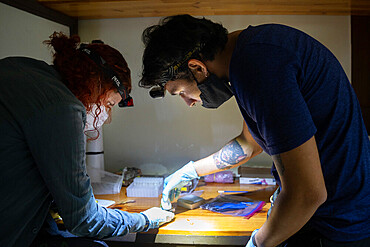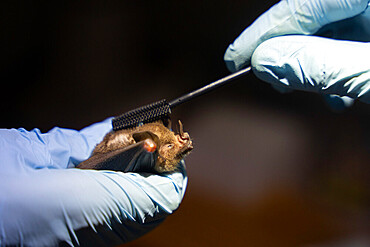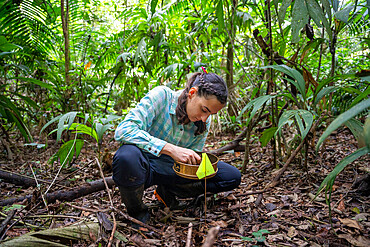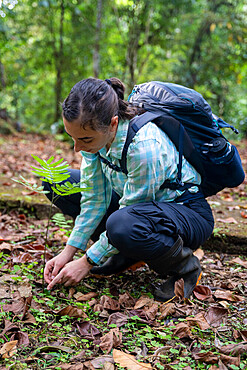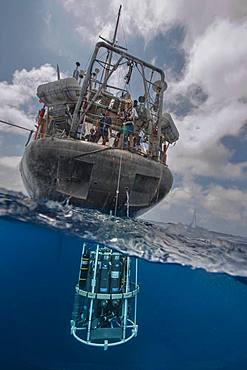Recent searches
Loading...
832-404441 - Digital nomad with laptop on veranda of tiny log house
832-403705 - Colleagues studying university library
860-291442 - Researcher photographing a 2.6 gram Stripe-throated Hermit hummingbird as part of a pollination study, rainforest at the "La Selva" research station in Puerto Viejo de Sarapiqui, Costa Rica
860-291441 - Researcher measuring a 2.6 gram Stripe-throated Hermit hummingbird wing as part of a pollination study, rainforest at the "La Selva" research station in Puerto Viejo de Sarapiqui, Costa Rica
860-291439 - Researcher measuring the beak of a Rufous-tailed hummingbird as part of a pollination study, rainforest at the "La Selva" research station in Puerto Viejo de Sarapiqui, Costa Rica
860-291440 - Researchers picking up pollen with a brush from the beak of a hummingbird Stripe-throated Hermit as part of a pollination study, rainforest at the "La Selva" research station in Puerto Viejo de Sarapiqui, Costa Rica
860-291438 - Researchers picking up pollen with a brush from the beak of a Rufous-tailed hummingbird as part of a pollination study, rainforest at the "La Selva" research station in Puerto Viejo de Sarapiqui , Costa Rica
860-291436 - Researcher catching Rufous-tailed Hummingbird (Amazilia Tzacatl) in a net set up for pollination study, rainforest at "La Selva" research station in Puerto Viejo de Sarapiqui, Costa Rica
860-291437 - Researchers picking up pollen using tape on the beak of a Rufous-tailed hummingbird as part of a pollination study, rainforest at the "La Selva" research station in Puerto Viejo de Sarapiqui, Costa Rica
860-291434 - Researcher setting up a net to capture hummingbirds as part of a pollination study, rainforest at the "La Selva" research station in Puerto Viejo de Sarapiqui, Costa Rica
860-291435 - Rufous-tailed Hummingbird (Amazilia tzacatl) in a net set up by a researcher as part of a pollination study, rainforest at the "La Selva" research station in Puerto Viejo de Sarapiqui, Costa Rica
860-291433 - Fringe-lipped Bat (Trachops cirrhosus) in the hand of a scientist as part of a pollination study, tropical forest at the "La Selva" research station in Puerto Viejo de Sarapiqui, Costa Rica
860-291432 - Bat caught in a net as part of a pollination study, rainforest at the "La Selva" research station in Puerto Viejo de Sarapiqui, Costa Rica
860-291431 - Researcher unhooking a bat caught in a net as part of a pollination study, rainforest at the "La Selva" research station in Puerto Viejo de Sarapiqui, Costa Rica
860-291430 - Researchers applying a mascara brush to the hairs of a Sowell's short-tailed bat (Carollia sowelli) to test methods to capture pollen that bats may carry as part of a pollination study, rainforest at the "La Selva" research station in Puerto Viejo de Sarapiqui, Costa Rica
860-291429 - 3 microscope slides to analyze pollen transported on bat hairs, "La Selva" research station in Puerto Viejo de Sarapiqui, Costa Rica
860-291427 - Researchers applying tape to the hairs of a bat to test methods to capture the pollen it carries as part of a pollination study, rainforest at the 'La Selva' research station in Puerto Viejo de Sarapiqui, Costa Rica
860-291428 - Researchers applying a mascara brush to the hairs of a Sowell's short-tailed bat (Carollia sowelli) to test methods to capture pollen that bats may carry as part of a pollination study, rainforest at the "La Selva" research station in Puerto Viejo de Sarapiqui, Costa Rica
860-291426 - Sowell's short-tailed bat (Carollia sowelli) caught as part of a pollination study, rainforest at the "La Selva" research station in Puerto Viejo de Sarapiqui, Costa Rica
860-291424 - Net for catching bats as part of a pollination study, rainforest at the "La Selva" research station in Puerto Viejo de Sarapiqui, Costa Rica
860-291425 - Sowell's short-tailed bat (Carollia sowelli) caught as part of a pollination study, rainforest at the "La Selva" research station in Puerto Viejo de Sarapiqui, Costa Rica
860-291423 - Installation of a sign on a hiking trail indicating the presence of nets to capture bats as part of a pollination study, rainforest of the "La Selva" research station in Puerto Viejo de Sarapiqui, Costa Ricardo
860-291421 - 27-year-old female researcher working on nitrogen exchange between bacteria and the roots of legumes showing an example of a nodule of bacteria attached to the roots in the rainforest of the "La Selva" research station in Puerto Viejo de Sarapiqui, Costa Rica
860-291422 - Earth diluted with water in order to extract the PH from the soil as part of a study on nitrogen exchanges between bacteria and the roots of legumes in the tropical forest of the "La Selva" research station in Puerto Viejo from Sarapiqui, Costa Rica
860-291420 - Earth diluted with water in order to extract the PH from the soil as part of a study on nitrogen exchanges between bacteria and the roots of legumes in the tropical forest of the "La Selva" research station in Puerto Viejo from Sarapiqui, Costa Rica
860-291419 - 27-year-old researcher working in a lab on nitrogen exchange between bacteria and the roots of legumes in the rainforest at the "La Selva" research station in Puerto Viejo de Sarapiqui, Costa Rica
860-291418 - 27-year-old researcher and her team working on nitrogen exchange between bacteria and the roots of legumes in the rainforest at the "La Selva" research station in Puerto Viejo de Sarapiqui, Costa Rica
860-291417 - Research assistant working on nitrogen exchanges between bacteria and the roots of legumes in the tropical forest of the "La Selva" research station in Puerto Viejo de Sarapiqui, Costa Rica
860-291415 - 27-year-old researcher working on nitrogen exchange between bacteria and the roots of legumes in the rainforest at the "La Selva" research station in Puerto Viejo de Sarapiqui, Costa Rica
860-291416 - 27-year-old researcher working on nitrogen exchange between bacteria and the roots of legumes in the rainforest at the "La Selva" research station in Puerto Viejo de Sarapiqui, Costa Rica
860-291414 - 29-year-old assistant researcher working on nitrogen exchange between bacteria and the roots of legumes in the rainforest at the "La Selva" research station in Puerto Viejo de Sarapiqui, Costa Rica
860-291413 - 27-year-old researcher working on nitrogen exchange between bacteria and the roots of legumes in the rainforest at the "La Selva" research station in Puerto Viejo de Sarapiqui, Costa Rica
860-291412 - Research assistant working on nitrogen exchanges between bacteria and the roots of legumes in the tropical forest of the "La Selva" research station in Puerto Viejo de Sarapiqui, Costa Rica
860-291411 - Instrument for measuring soil humidity at research station ?La Selva? in Puerto Viejo de Sarapiqui, Costa Rica
860-291409 - 27-year-old researcher working on nitrogen exchange between bacteria and the roots of legumes in the rainforest at the "La Selva" research station in Puerto Viejo de Sarapiqui, Costa Rica
860-291410 - 27-year-old researcher working on nitrogen exchange between bacteria and the roots of legumes in the rainforest at the "La Selva" research station in Puerto Viejo de Sarapiqui, Costa Rica
860-291408 - 27-year-old researcher and her team working on nitrogen exchange between bacteria and the roots of legumes in the rainforest at the "La Selva" research station in Puerto Viejo de Sarapiqui, Costa Rica
860-291407 - Researchers walking through the rainforest at the "La Selva" research station in Puerto Viejo de Sarapiqui, Costa Rica
860-291406 - 27-year-old researcher in front of the Pracaxi legume (Pentaclethra macroloba) at the "La Selva" research station in Puerto Viejo de Sarapiqui, Costa Rica
832-400321 - Beautiful African American girl with dark curly hair standing near board and giving presentation to colleagues in office. Young business woman looking on her coworkers while discussing new project
832-400302 - Beautiful African American girl with dark curly hair standing near board and giving presentation to colleagues in office. Young business woman looking on her coworkers while discussing new project
832-398521 - Female doctor vaccinating her colleague
1350-6425 - Male scientist in a biosafety cabinet with test tubes in a laboratory. Basque Country, Spain, Europe.
1350-6424 - Mature scientist male in his 50s wearing a lab coat looking through a microscope in a laboratory. Basque Country, Spain, Europe.
1348-5566 - Asian young girl student scientist researching and learning in a laboratory.
1348-5558 - Asian senior scientist male researching and learning in a laboratory.
1348-5563 - Asian young student scientist researching with a microscope in a laboratory.
1348-5557 - Asian senior scientist researching and learning in a laboratory.
1348-5564 - Asian young girl student scientist is writing and researching in laboratory.
1348-5560 - Asian young girl student scientist researching and learning in a laboratory.
1348-5567 - Asian young girl student scientist researching and learning in a laboratory.
1348-5561 - Asian young girl student scientist is writing and researching in laboratory.
1348-5562 - Asian man scientist researching and learning in a laboratory.
1348-5559 - Asian young man student scientist researching and learning in a laboratory.
1116-49671 - Research divers from the MOC Marine Institute map out coral damage at Molokini Marine Preserve off the island of Maui, Hawaii. In the future, data from here will help to determine the health of Hawaii's reefs, Maui, Hawaii, United States of America
1116-49673 - Research divers from the MOC Marine Institute glue broken coral heads back together and map out coral damage at Molokini Marine Preserve off the island of Maui, Hawaii. In the future, data from here will help to determine the health of Hawaii's reefs, Maui, Hawaii, United States of America
860-287453 - Tara Oceans Expeditions - May 2011. CTD-Rosette (Conductivity Temperature Density instrumental platform with 7 additional sensors), Galapagos
860-287454 - Tara Oceans Expeditions - May 2011. CTD-Rosette (Conductivity Temperature Density instrumental platform with 7 additional sensors), galapagos
860-287451 - Tara Oceans Expeditions - May 2011. Surface plancton nets, deployed from Tara, Galapagos
860-287455 - Tara Oceans Expeditions - May 2011. CTD-Rosette (Conductivity Temperature Density instrumental platform with 7 additional sensors), Galapagos
860-287452 - Tara Oceans Expeditions - May 2011. CTD-Rosette (Conductivity Temperature Density instrumental platform with 7 additional sensors)
860-287456 - Tara Oceans Expeditions - May 2011. CTD-Rosette (Conductivity Temperature Density instrumental platform with 7 additional sensors), Galapagos
860-287449 - Tara Oceans Expeditions - May 2011. Surface plancton nets, deployed from Tara, Galapagos
860-287450 - Tara Oceans Expeditions - May 2011. Tara with deployed plancton nets. On "station", the boat is drifting without engine or sails. Tara Oceans, a unique expedition: Tara Oceans is the very first attempt to make a global study of marine plankton, a form of sea life that includes organisms as small as viruses and bacterias, and as big as medusas. Our goal is to better understand planktonic ecosystems by exploring the countless species, learning about interactions among them and with their environment. Marine plankton is the only ecosystem that is almost continuous over the surface of the Earth. Studying plankton is like taking the pulse of our planet. Recently, scientists have discovered the great importance of plankton for the climate: populations of plankton are affected very rapidly by variations in climate. But in turn they can influence the climate by modifying the absorption of carbon. In a context of rapid physico-chemical changes, for example the acidification observed today in the world's oceans, it is urgent to understand and predict the evolution of these particular ecosystems. Finally, plankton is an astonishing way of going back in time ? a prime source of fossils. Over the eons, plankton has created several hundred meters of sediment on the ocean floors. This allows us to go back in time, to the first oceans on Earth, and better understand the history of our biosphere. More than 12 fields of research are involved in the project, which will bring together an international team of oceanographers, ecologists, biologists, geneticists, and physicists from prestigious laboratories headed by Eric Karsenti of the European Molecular Biology Laboratory. Galapagos
860-287439 - Tara Pacific expedition - november 2017 Tara in Kimbe Bay, papua New Guinea, H: 103,6 m, mandatory credit line: Photo: Christoph Gerigk, drone pilot: Guillaume Bourdin - Tara Expeditions Foundation
860-285137 - Banding Firecrest captured by net, France
860-285423 - Guanay Cormorant colony, Pescadores guano island Peru
860-283871 - Lesser Spotted Woodpecker hanging, Alsace France
860-285139 - Banding Firecrest captured by net, France
832-98638 - Neue Philologische Bibliothek or new philological library of the Freie Universitaet Berlin university, designed by Norman Foster, Berlin, Germany, Europe
1036-208 - New Zealand Whale and Dolphin Trust working with Hectors dolphins (Cephalorhynchus hectori) Akaroa, South Island: New Zealand.
1036-207 - New Zealand Whale and Dolphin Trust working with Hector's dolphins (Cephalorhynchus hectori)
911-79 - A thermometer taking the air temperature as part of a study to measure the speed of the Russell Glacier near Kangerlussuaq Greenland, Polar Regions
911-147 - PhD scientist Ian Bartholomew taking measurements as part of a study to measure the speed of the Russell Glacier near Kangerlussuaq, Greenland, Polar Regions
911-76 - PHD scientist Ian Bartholomew using dye tracing techniques as part of a study to measure the speed of the Russell Glacier near Kangerlussuaq, Greenland, Polar Regions
911-5967 - Robert Simpson takes soil samples to measure the level of methanotropic bacteria during an experiment by scientists from Sydney University, in the Snowy mountains, New South Wales, Australia Pacific
911-5954 - Solar panels used to generate electricity to power scientific equipment as part of a research project by scientists from Sydney University, in the Snowy Mountains, New South Wales, Australia, Pacific
911-58 - PHD scientist Ian Bartholomew taking measurements as part of a study to measure the speed of the Russell Glacier near Kangerlussuaq, Greenland, Polar Regions
911-78 - PhD scientist Ian Bartholomew taking measurements as part of a study to measure the speed of the Russell Glacier near Kangerlussuaq, Greenland, Polar Regions
911-71 - PHD scientist Ian Bartholomew using dye tracing techniques as part of a study to measure the speed of the Russell Glacier near Kangerlussuaq, Greenland, Polar Regions
911-138 - Water temperatures being taken from the meltwater river at the snout of the Russell Glacier near Kangerlussuaq in Greenland, Polar Regions
911-5970 - A scientific experiment by scientists from Sydney University, in the Snowy Mountains, New South Wales, Australia, Pacific
911-57 - PHD scientist Ian Bartholomew taking measurements as part of a study to measure the speed of the Russell Glacier near Kangerlussuaq, Greenland, Polar Regions
911-327 - An American Air Force plane after a resupply flight to the science base on the summit of the Greenland Ice sheet, Kangerlussuaq Airport, Greenland, Polar Regions
911-328 - An American Air Force plane after a resupply flight to the science base on the summit of the Greenland Ice sheet, Kangerlussuaq Airport, Greenland, Polar Regions
911-329 - A plane at Kangerlussuaq airport used to fly transect flights over the Greenland ice sheet to measure air pollution from forest fires in Siberia, Greenland, Polar Regions
911-5964 - A scientific experiment by scientists from Sydney University, in the Snowy Mountains, New South Wales, Australia, Pacific
911-70 - PHD scientist Ian Bartholomew using dye tracing techniques as part of a study to measure the speed of the Russell Glacier near Kangerlussuaq, Greenland, Polar Regions
911-77 - PhD scientist Ian Bartholomew taking measurements as part of a study to measure the speed of the Russell Glacier near Kangerlussuaq, Greenland, Polar Regions
911-75 - PHD scientist Ian Bartholomew using dye tracing techniques as part of a study to measure the speed of the Russell Glacier near Kangerlussuaq, Greenland, Polar Regions
911-72 - PHD scientist Ian Bartholomew using dye tracing techniques as part of a study to measure the speed of the Russell Glacier near Kangerlussuaq, Greenland, Polar Regions
911-5965 - A scientific experiment by scientists from Sydney University, in the Snowy Mountains, New South Wales, Australia, Pacific


















